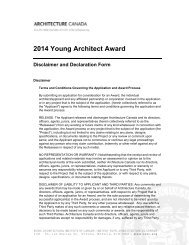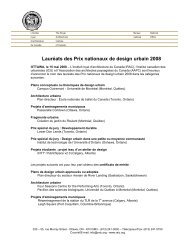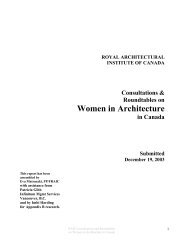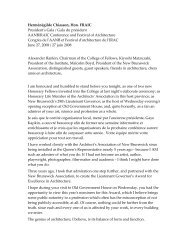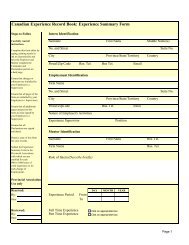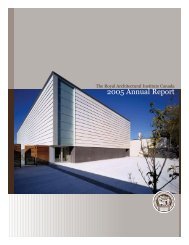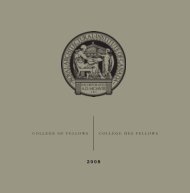Benchmark Study on Green Buildings - Royal Architectural Institute ...
Benchmark Study on Green Buildings - Royal Architectural Institute ...
Benchmark Study on Green Buildings - Royal Architectural Institute ...
Create successful ePaper yourself
Turn your PDF publications into a flip-book with our unique Google optimized e-Paper software.
into a clean energy future and require science and technology (S&T) investments now,<br />
e.g. hydrogen fuel cells and producti<strong>on</strong>, and carb<strong>on</strong> dioxide (CO 2 ) capture and storage.<br />
The T&I R&D initiative balances support between projects that are meant to achieve<br />
short-term GHG reducti<strong>on</strong>s immediately, and projects aimed at changing industry and<br />
society for reducti<strong>on</strong>s in the future. T&I R&D currently funds 11 energy R&D programs.<br />
Please see http://www2.nrcan.gc.ca/ES/OERD/english/View.asp?x=1321 for a complete<br />
list of T&I R&D-funded programs.<br />
Another smaller program run by the OERD is the Community Energy Systems Program<br />
(CES). The CES program helps Canadian communities meet their energy needs more<br />
efficiently and cost-effectively. The program identifies and develops opportunities for the<br />
use of district heating and cooling, combined heat and power (co-generati<strong>on</strong>), waste heat<br />
recovery, thermal storage, and local sources of renewable energy, particularly biomass.<br />
Interests include: planning and implementing projects in both urban centres and remote<br />
communities; developing software for system design; improving performance of district<br />
cooling systems; and promoting and fostering the adopti<strong>on</strong> of integrated energy systems.<br />
CES operates a laboratory to test and develop district energy technologies. This enables<br />
systems to be simulated and quick resp<strong>on</strong>ses to clients’ problems. In additi<strong>on</strong> to serving<br />
all three levels of government, the CES’s clients also include engineering firms, energy<br />
equipment manufacturers and utilities. Clients use the program's capabilities to: develop<br />
community energy plans; c<strong>on</strong>duct feasibility studies; design district heating and cooling<br />
systems; help with project management; c<strong>on</strong>duct trouble-shooting that requires<br />
specialized expertise; develop system-design software; develop innovative enhancements<br />
to new and existing equipment; develop new district cooling technologies; write technical<br />
and promoti<strong>on</strong>al manuals; and help link system suppliers with potential adopters. The<br />
CES initiative also provides project funding, with the funding criteria being: technical<br />
merit; leveraging; Canadian c<strong>on</strong>tent; innovativeness; community impacts; ec<strong>on</strong>omic<br />
c<strong>on</strong>siderati<strong>on</strong>s; and envir<strong>on</strong>mental c<strong>on</strong>siderati<strong>on</strong>s.<br />
The <strong>Buildings</strong> Energy Technology Program (BET) is another program put forward by the<br />
OERD, and is meant to accelerate the development and use of energy-efficient residential<br />
and commercial building technologies, from R&D and field trials through to technology<br />
transfer and commercializati<strong>on</strong>. Working domestically and internati<strong>on</strong>ally with<br />
associati<strong>on</strong>s, governments and industry, BET advances the design, c<strong>on</strong>structi<strong>on</strong> and<br />
operati<strong>on</strong> of buildings for superior energy efficiency and envir<strong>on</strong>mental performance.<br />
The program funds projects that involve research and development, disseminati<strong>on</strong> and<br />
deployment related to building technologies and tools that increase energy efficiency,<br />
lessen overall envir<strong>on</strong>mental impacts, and projects that are replicable in the Canadian<br />
housing and commercial building industry. Companies with projects that they believe are<br />
eligible for support are encouraged to c<strong>on</strong>tact the BET for a preliminary project<br />
assessment. Interested parties must complete a submissi<strong>on</strong> form. This assessment requires<br />
a project descripti<strong>on</strong>, estimates of impacts, estimates of project costs, as well as the total<br />
amount of financial support sought. A project is evaluated <strong>on</strong>, am<strong>on</strong>gst other things, its<br />
own merits in terms of: potential energy savings; technological uniqueness; potential for<br />
widespread adopti<strong>on</strong> in Canada; and leveraging of funds. If the initial assessment is<br />
positive, and funds are available, a full project submissi<strong>on</strong> is requested e.g. a detailed<br />
63



